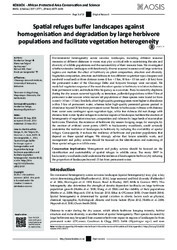| dc.contributor.author | Van Langevelde, Frank | |
| dc.contributor.author | Sianga, Keoikantse | |
| dc.contributor.author | Van Telgen, Mario | |
| dc.contributor.author | Vrooman, Jip | |
| dc.contributor.author | Fynn, Richard | |
| dc.date.accessioned | 2022-03-29T13:13:39Z | |
| dc.date.available | 2022-03-29T13:13:39Z | |
| dc.date.issued | 2017-08-16 | |
| dc.identifier.citation | Van Langevelde, F., Sianga, K., Van Telgen, M., Vrooman, J., & Fynn, R. W. (2017). Spatial refuges buffer landscapes against homogenisation and degradation by large herbivore populations and facilitate vegetation heterogeneity. Koedoe: African Protected Area Conservation and Science, 59(2), 1-13. | en_US |
| dc.identifier.issn | 2071-0771 | |
| dc.identifier.issn | 0075-6458 | |
| dc.identifier.uri | https://journals.co.za/doi/epdf/10.4102/koedoe.v59i2.1434 | |
| dc.identifier.uri | https://hdl.handle.net/13049/406 | |
| dc.description | This work is licensed under the Creative Commons Attribution License | en_US |
| dc.description.abstract | Environmental heterogeneity across savanna landscapes, including different seasonal resources at different distances to water, may play a critical role in maintaining the size and diversity of wildlife populations and the sustainability of their resource base. We investigated whether extensive landscapes with functionally diverse seasonal resources and large waterless regions can mediate the effect of herbivory on plant composition, structure and diversity. Vegetation composition, structure and richness in two different vegetation types (mopane and sandveld woodland) at three distance zones (0 km – 5 km, 10 km – 15 km and > 20 km) from the permanent water of the Okavango Delta and Linyanti Swamps were surveyed. We modelled vegetation response of the most abundant species to herbivory in relation to distance from permanent water, and included fire frequency as a covariate. Trees favoured by elephants during the dry season occurred typically as immature, pollarded populations within 5 km of permanent water sources while mature tall populations of these species were found far from water (> 10 km – 15 km). Similarly, short high-quality grazing grasses were higher in abundance within 5 km of permanent water, whereas taller high-quality perennial grasses peaked in abundance beyond 20 km from permanent water. Trends in herbaceous richness with distance from water were contingent upon vegetation type, while tree richness did not change with distance from water. Spatial refuges in waterless regions of landscapes facilitate the creation of heterogeneity of vegetation structure, composition and richness by large herds of mammalian herbivores. Therefore, the extension of herbivore dry season foraging range, for example, by the creation of artificial water points (AWP) in backcountry woodlands, could seriously undermine the resilience of landscapes to herbivory by reducing the availability of spatial refuges. Consequently, it reduces the resilience of herbivore and predator populations that depend on these spatial refuges. We strongly advise that future scientific work, and management and policy actions should be focused on the identification and sustaining of these spatial refuges in wildlife areas. Conservation implications: Management and policy actions should be focused on the identification and sustainability of spatial refuges in wildlife areas. Too many AWP in backcountry woodlands could undermine the resilience of landscapes to herbivory by reducing the proportion of landscapes beyond 15 km from permanent water. | en_US |
| dc.language.iso | en | en_US |
| dc.publisher | Sabinet African Journals | en_US |
| dc.relation.ispartofseries | African Protected Area Conservation and Science;59(2), 1-13 | |
| dc.title | Spatial refuges buffer landscapes against homogenisation and degradation by large herbivore populations and facilitate vegetation heterogeneity. | en_US |
| dc.type | Article | en_US |

